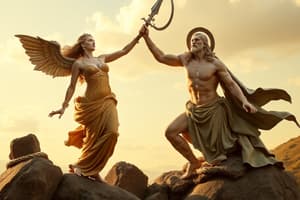Podcast
Questions and Answers
What type of offering was the most popular way to honor the gods in ancient Greece?
What type of offering was the most popular way to honor the gods in ancient Greece?
The killing of an animal as a blood sacrifice.
What was the first step in preparing the animal for sacrifice?
What was the first step in preparing the animal for sacrifice?
Ensuring the animal was clean and well.
The sacrifice was just a simple act of killing the animal without any ceremony.
The sacrifice was just a simple act of killing the animal without any ceremony.
False (B)
The choice of animal for sacrifice was based solely on its price.
The choice of animal for sacrifice was based solely on its price.
The most expensive sacrifices were usually offered during routine household rituals.
The most expensive sacrifices were usually offered during routine household rituals.
The preparation for the sacrifice involved participants wearing their best clothes and ______ of leaves or twigs.
The preparation for the sacrifice involved participants wearing their best clothes and ______ of leaves or twigs.
The killing of the animal involved a simple cut to the animal's throat.
The killing of the animal involved a simple cut to the animal's throat.
Why were the animal's hairs thrown into the fire during the sacrifice?
Why were the animal's hairs thrown into the fire during the sacrifice?
Why was it important for the animal to be seen nodding during the sacrifice?
Why was it important for the animal to be seen nodding during the sacrifice?
The first recipient of the sacrificed meat was the god for whom the sacrifice was intended.
The first recipient of the sacrificed meat was the god for whom the sacrifice was intended.
What part of the sacrificed animal was given to the god?
What part of the sacrificed animal was given to the god?
What was the reasoning for offering the bones and fat to the gods, instead of the meat?
What was the reasoning for offering the bones and fat to the gods, instead of the meat?
The remaining meat from the sacrifice was consumed only by the participants of the ritual.
The remaining meat from the sacrifice was consumed only by the participants of the ritual.
The animal skin was thrown away after the sacrifice.
The animal skin was thrown away after the sacrifice.
Flashcards
What were offerings to the Greek gods?
What were offerings to the Greek gods?
Offerings to Greek gods could include gifts of money, dedications of songs, war booty, and food sacrifices. The most common offerings were the sacrifice of animals.
What was the primary method of offering food to the gods?
What was the primary method of offering food to the gods?
The main method of offering food to the gods was through the killing of an animal as a blood sacrifice.
Describe the process of offering a sacrifice.
Describe the process of offering a sacrifice.
Sacrificing an animal was a carefully planned ritual with multiple stages, including choosing the right animal, preparing it, sacrificing it, and sharing the meat.
What factors determined the choice of animal for sacrifice?
What factors determined the choice of animal for sacrifice?
Signup and view all the flashcards
What was a hecatomb?
What was a hecatomb?
Signup and view all the flashcards
What were the three parts of a sacrifice?
What were the three parts of a sacrifice?
Signup and view all the flashcards
What was the significance of being 'clean' before a sacrifice?
What was the significance of being 'clean' before a sacrifice?
Signup and view all the flashcards
Explain the symbolism of gilding the animal's horns.
Explain the symbolism of gilding the animal's horns.
Signup and view all the flashcards
What was the role of the maiden in the sacrifice procession?
What was the role of the maiden in the sacrifice procession?
Signup and view all the flashcards
What was the importance of musicians during the procession?
What was the importance of musicians during the procession?
Signup and view all the flashcards
Why was it important for the animal to agree to the sacrifice?
Why was it important for the animal to agree to the sacrifice?
Signup and view all the flashcards
What role did the altar play in the sacrifice?
What role did the altar play in the sacrifice?
Signup and view all the flashcards
What was the significance of throwing grain into the fire?
What was the significance of throwing grain into the fire?
Signup and view all the flashcards
Explain the significance of removing the animal's hairs and throwing them into the fire.
Explain the significance of removing the animal's hairs and throwing them into the fire.
Signup and view all the flashcards
What was the importance of pouring the animal's blood over the altar?
What was the importance of pouring the animal's blood over the altar?
Signup and view all the flashcards
Why did women scream during the sacrifice?
Why did women scream during the sacrifice?
Signup and view all the flashcards
What was the god's portion of the sacrifice?
What was the god's portion of the sacrifice?
Signup and view all the flashcards
Why were the thigh bones and fat offered to the god?
Why were the thigh bones and fat offered to the god?
Signup and view all the flashcards
What was the purpose of reading the animal's entrails?
What was the purpose of reading the animal's entrails?
Signup and view all the flashcards
How was the sacrificial meat shared?
How was the sacrificial meat shared?
Signup and view all the flashcards
What was the significance of the communal feast?
What was the significance of the communal feast?
Signup and view all the flashcards
What was the significance of the animal skin being given to the sanctuary?
What was the significance of the animal skin being given to the sanctuary?
Signup and view all the flashcards
What were the benefits of sacrifice for the Greeks?
What were the benefits of sacrifice for the Greeks?
Signup and view all the flashcards
Study Notes
Greek Sacrifices
- Greeks offered gods various gifts, including money, songs, war spoils, and food, with animal sacrifices being most common.
- Sacrifices weren't just killing an animal; they involved a ritual.
- The correct animal, usually domestic livestock belonging to the sacrificer, was chosen. Different animals suited different gods.
- Some individuals or cities (during festivals) did not restrict the expense, with a hecatomb (100 oxen) being very costly for major events like Panathenaia and Olympics. An ox sacrifice cost approximately 8,000 drachmae (34kg of silver).
- This ritual involved three stages: preparation, killing, and sharing.
Preparation
- Participants cleaned and dressed in best attire, including garlands, depending on the specific sacrifice.
- Animals had horns gilded if applicable.
- Attendants escorted the animal to the altar with items like barley grains or cakes (sometimes in a hidden basket that had a sacrificial knife).
- A large procession, involving musicians and water carriers, sometimes took place, especially for larger sacrifices. Music and water were important to avoid frightening the animal.
- Participants cleansed themselves with water at the sanctuary before moving to the altar.
- The participants lit the altar, took grain, and poured water on the animal's head to get their consent.
- The chief sacrificer then prayed to the god, and participants threw their grain into the fire.
Killing
- The chief sacrificer removed animal hair and threw it into the fire.
- The animal's throat was cut.
- Blood was collected in bowls for small animals and a bowl, while animal's blood was poured on the altar for larger ones.
- Women often made high-pitched screams during the killing to signify the passage of life to death.
Sharing
- The gods received the animal's best parts first, specifically the thigh bones wrapped in fat. This was then burned on the altar, with wine poured over the offerings.
- After the gods’ portions, the entrails of the animal were examined for omens.
- Any remaining meat was cooked and shared with attendees.
- This was a communal event, as meat was not a regular part of the Greek diet, making sacrifice a special occasion.
- The animal skin was left at the sanctuary.
Studying That Suits You
Use AI to generate personalized quizzes and flashcards to suit your learning preferences.





